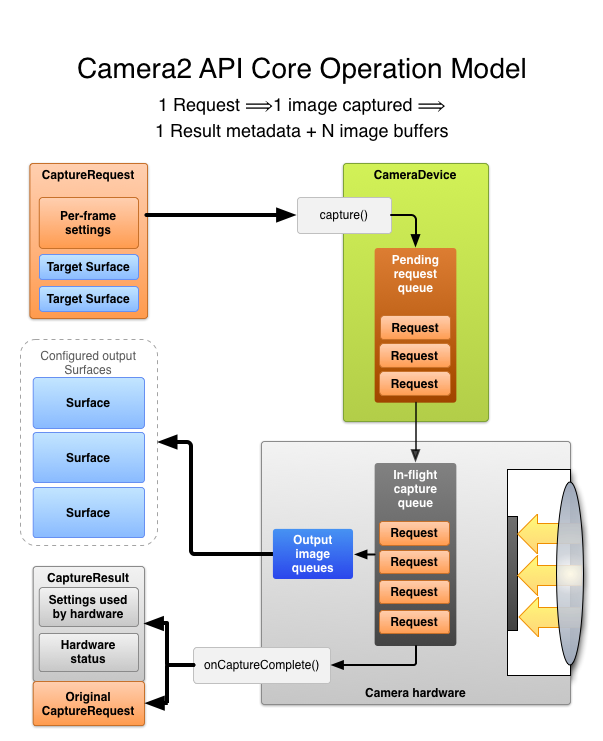Quick Note: Android Camera2 and Support For External ISPs
by Joshua Ho on November 9, 2014 3:21 PM EST- Posted in
- Smartphones
- Android
- Mobile
- Lollipop
- Android 5.0

While we've written about Android's Camera2 API before, there was one notable aspect of the discussion that was missing. The missing piece was a discussion of the physical link needed to enable all of the controls that were previously discussed. This isn't necessarily complicated, but it does represent a potential pitfall for updates to current devices. In short, the current protocols for using an external ISP provide insufficient bandwidth to support the full feature set needed for the new camera API.
This means that some of the interesting features, such as per-frame controls are impossible to enable. As a result, many devices that we've evaluated before such as the Galaxy S4 Snapdragon, Motorola Moto X (2013), HTC One (M7), and One (M8) won't support per-frame controls and similarly bandwidth-heavy features. The Galaxy Note 3, S5, S4 Exynos, Note 4, and all Nexus device should support the full set of features in camera2 as they seem to only use an on-die ISP.
To understand why this is, we must understand the protocol that is used for communication. Today, the de facto standard for interfacing between the AP (application processor), ISP, and camera is MIPI's CSI protocol. By and large, CSI-1 and CSI-2 are the most common iterations of this protocol. While the transport protocol (D-PHY) that actually carries the images has immense amounts of bandwidth (up to 10 Gbps), the control protocol defined has almost no bandwidth in comparison. Instead, the control protocol relies on fast-mode i2c, which can only provide 400 kbit/s of bandwidth.
While this may be an issue now, it seems that in the future this won't be an issue. According to Arrow Devices, the MIPI CSI-3 protocol merges control and transport protocols into a single M-PHY bus for up to 18.6 Gbps of bandwidth. It's likely that the demand for 4K60 video and 20+ megapixel burst mode functionality will drive adoption of this newer protocol. However, even now the disclosure of such protocols is rare, so it's hard to say whether we'll see widespread adoption of CSI-3 any time soon.










8 Comments
View All Comments
jjj - Sunday, November 9, 2014 - link
Not all that relevant but this reminded me that Project Ara is using UniPort-M and that Rockchip is making a SoC for them "with a native, general-purpose UniPro interface".willis936 - Monday, November 10, 2014 - link
M-PHY and CSI-3 have been out for well over a year and literally no one is using it because D-PHY and CSI-2 are good enough and when bandwidth becomes an issue because of higher resolutions they start using C-PHY which is designed to be able to use existing D-PHY IP and add an extra block on the end. Everyone's getting their money's worth with MIPI. It's only seen as bad when higher layers add features that are incompatible with the lower layers.JoshHo - Monday, November 10, 2014 - link
Interesting. As far as I can tell though C-PHY wouldn't solve the issue here as the control interface would still need i2c? Of course, this is assuming that it's worth the trouble to get full camera2 support with external ISP.SydneyBlue120d - Monday, November 10, 2014 - link
Another question: Is Apple using a custom proprietary solution or this it rely on this standard too? Could this be a reason why Apple devices are better tha all other devices in camera department? Thanks a lot.hpglow - Monday, November 10, 2014 - link
Apple has focused on larger pixel sizes, low light performance, and target acquisition speed rather than megapixel counts. Its quite obvious when you go from a Windows Phone back to an Apple phone as WP feels like it takes an eternity to get an object at take a picture. "Better" is relative to use, a Samsung Galaxy S5 takes much nicer photos in full sunlight IMO, has some nice features that my iPhone 5 doesn't, and is almost as fast getting a target. The only place it seems to fall short is all the noise in night time photos. An iPhone does take a nice photo given its sensor size, but when you need the detail that a 16MP+ sensor provides it just falls flat. Having all that extra pixel data sure is nice when you take an in the moment photo and need to edit the snot out of it. When it isn't there you are pretty much SOL.willis936 - Monday, November 10, 2014 - link
No switching over to C-PHY wouldn't change anything from the protocol's view, just get a bit more bandwidth out of existing PHY IP. I don't think companies are feeling the need to jump to a new PHY and protocol but you never know.SydneyBlue120d - Monday, November 10, 2014 - link
Very interesting, please let us know in future reviews of upcoming flagship devices (S GS6,LG G4, Sony Z4 and so on) if the new interface is being used.karandewan - Saturday, February 14, 2015 - link
Galaxy S4 Exynos doesn't support full set of features in camera2 !!